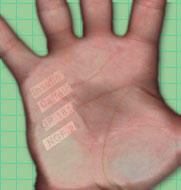
"New Genes"
 |
"New Genes" |
"Biotech breakthru creates fibers lighter than kevlar and more elastic." I am telling the truth, the genes for one of the world's strongest and lightest fibers - spider silk - have been transplated to potatoes and tobacco. Grow your own bullet proof vest, harvest your own parachute. Why stop there? Consider the value of using gene transplantation as a drug delivery system.
Let's say I'm a diabetic. I carve some skin cells from my hand, transplant the genes for insulin production and reimplant the skin cells. Dosage = Surface Area. Since they are my own cells, my immune system won't reject them or the gene products. Insulin is a protein. Want more, click here.
If the genes that control an entire synthesis pathway were transplanted the technique could be extended to treat addiction. Many addictive substances are non-protein substances of biological origin. A heroin addict could be transfected with poppy genes, maintained at zero cost and possibly resume a normal life. No more breaking and entering. Who gets that annuity stream? Sleepy in the morning? Transfect with the caffeine pathway cassette. You get the picture. Activate a pathway on exposure to light of a specific frequency, so you could control the dosage by surface area AND illumination. Splice me up a kinase, put me up for rhodopsin and don't forget to wear your gloves on sunny days...
Why stop there? Why not grid the entire palm of the hand with an entire medicine cabinet? Need more room? Grid the entire back. Forget tatoos. Illuminate that portion of your back that produces the substance that you need at any given moment. Forgot your medicine? Quid Pro Quo takes on new meaning.
But this is all boring! The brave new world includes designing special purpose pathways that synthesize substances that are not currently in the biopool of available metabolons. Take Gleevec for example. This substance, for all intents and purposes, cures chronic myeloid leukemia (CML) with the side effects of Tylenol. CML features the famous Philadelphia chromosome as its principle underlying bit of DNA damage. The task before the national coterie of organic chemists is to design a set of enzymes, that duplicate the in vitro synthesis track used to create Gleevec and install it as a permanent modification, a biograft plug-in if you will.
"Think globally, Act locally"
goes for gene therapy also: Instead of global transfection with carriers like
adenovirus that can have side effects that are difficult to predict, we transfect
locally to bounded regions of tissue that we can monitor and splice in and out
as necessary, before things get out of hand. Out of hand? Maybe things already
are. In any event, "Poppy Genes", looks like a new world order to
me. Drop me a line if you liked this essay...